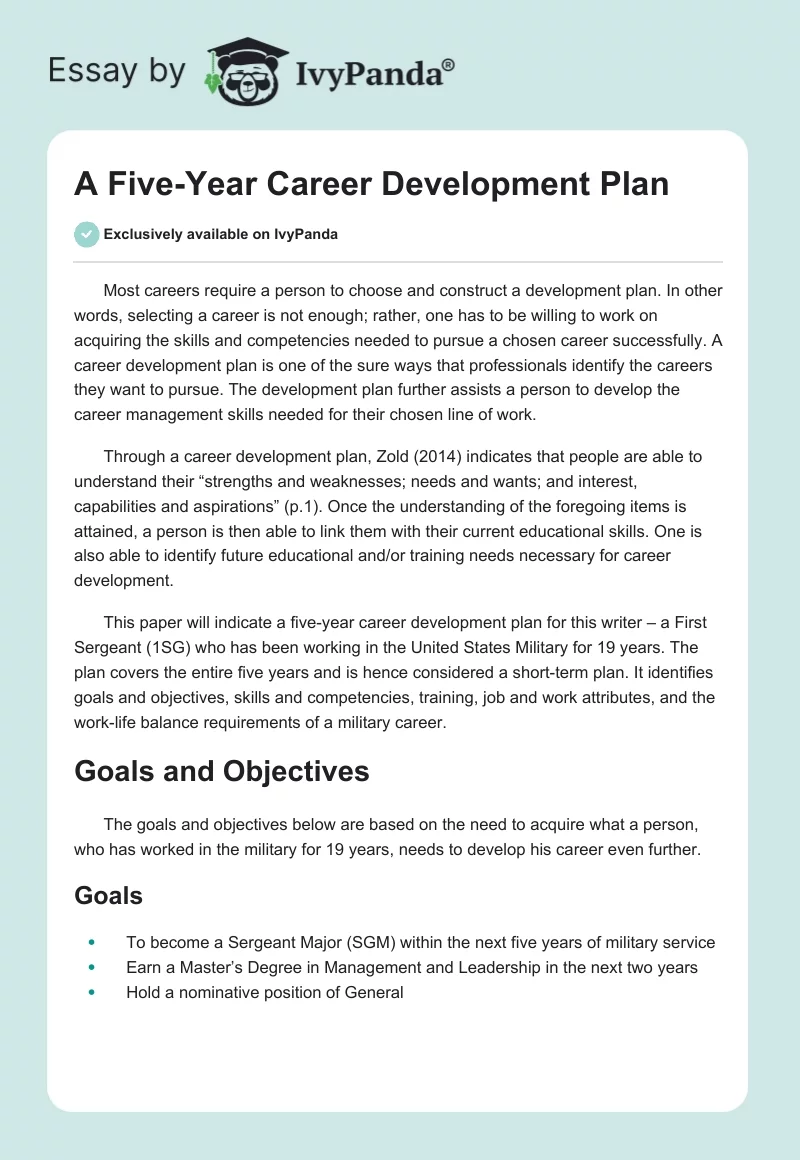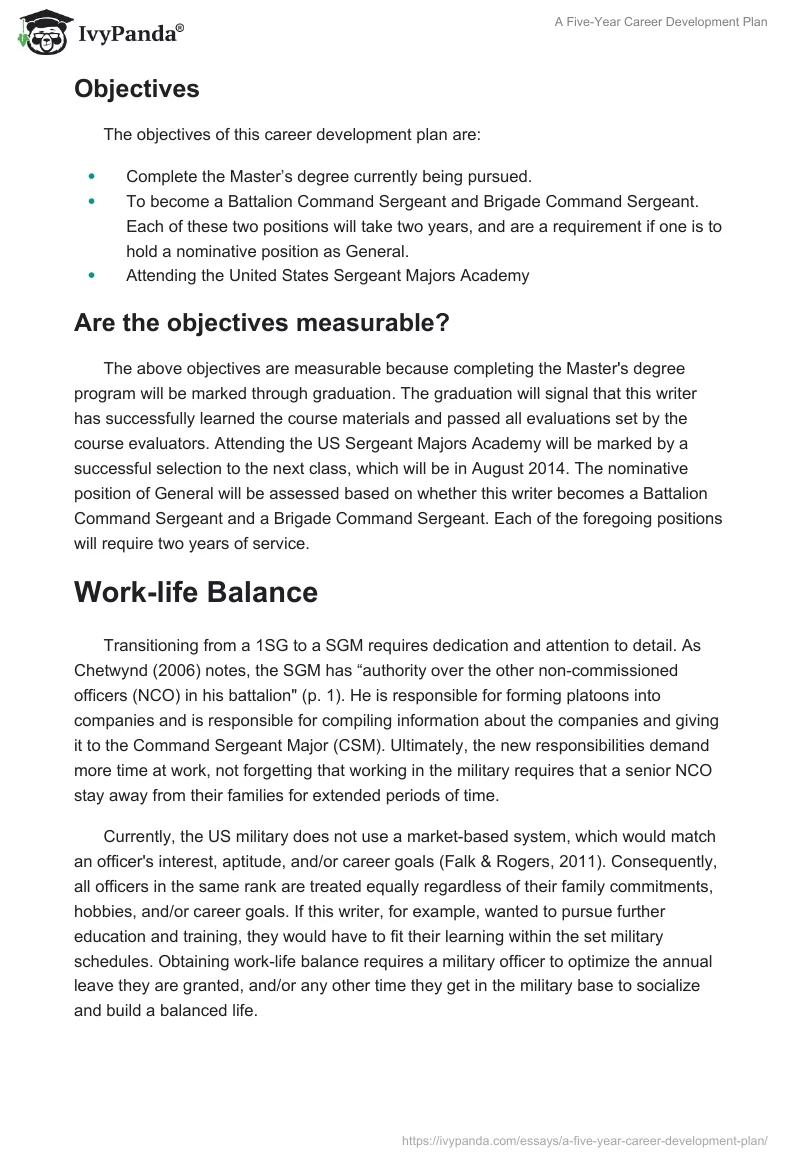Most careers require a person to choose and construct a development plan. In other words, selecting a career is not enough; rather, one has to be willing to work on acquiring the skills and competencies needed to pursue a chosen career successfully. A career development plan is one of the sure ways that professionals identify the careers they want to pursue. The development plan further assists a person to develop the career management skills needed for their chosen line of work.
Through a career development plan, Zold (2014) indicates that people are able to understand their “strengths and weaknesses; needs and wants; and interest, capabilities and aspirations” (p.1). Once the understanding of the foregoing items is attained, a person is then able to link them with their current educational skills. One is also able to identify future educational and/or training needs necessary for career development.
This paper will indicate a five-year career development plan for this writer – a First Sergeant (1SG) who has been working in the United States Military for 19 years. The plan covers the entire five years and is hence considered a short-term plan. It identifies goals and objectives, skills and competencies, training, job and work attributes, and the work-life balance requirements of a military career.
Goals and Objectives
The goals and objectives below are based on the need to acquire what a person, who has worked in the military for 19 years, needs to develop his career even further.
Goals
- To become a Sergeant Major (SGM) within the next five years of military service.
- Earn a Master’s Degree in Management and Leadership in the next two years.
- Hold a nominative position of General.
Objectives
The objectives of this career development plan are:
- Complete the Master’s degree currently being pursued.
- To become a Battalion Command Sergeant and Brigade Command Sergeant. Each of these two positions will take two years, and are a requirement if one is to hold a nominative position as General.
- Attending the United States Sergeant Majors Academy.
Are the objectives measurable?
The above objectives are measurable because completing the Master’s degree program will be marked through graduation. The graduation will signal that this writer has successfully learned the course materials and passed all evaluations set by the course evaluators. Attending the US Sergeant Majors Academy will be marked by a successful selection to the next class, which will be in August 2014. The nominative position of General will be assessed based on whether this writer becomes a Battalion Command Sergeant and a Brigade Command Sergeant. Each of the foregoing positions will require two years of service.
Work-life Balance
Transitioning from a 1SG to a SGM requires dedication and attention to detail. As Chetwynd (2006) notes, the SGM has “authority over the other non-commissioned officers (NCO) in his battalion” (p. 1). He is responsible for forming platoons into companies and is responsible for compiling information about the companies and giving it to the Command Sergeant Major (CSM). Ultimately, the new responsibilities demand more time at work, not forgetting that working in the military requires that a senior NCO stay away from their families for extended periods of time.
Currently, the US military does not use a market-based system, which would match an officer’s interest, aptitude, and/or career goals (Falk & Rogers, 2011). Consequently, all officers in the same rank are treated equally regardless of their family commitments, hobbies, and/or career goals. If this writer, for example, wanted to pursue further education and training, they would have to fit their learning within the set military schedules. Obtaining work-life balance requires a military officer to optimize the annual leave they are granted, and/or any other time they get in the military base to socialize and build a balanced life.
Trends to Be Aware Of
According to Chetwynd (2006) the position of an SGM should be occupied by a qualified and competent person. Specifically, the author argues that besides being a complete Sergeant, a person who seeks to occupy the SGM rank should “be sensible, sedate…and must be above conniving at the least irregularities committed by the non-commissioned officers or soldiers” to whom he is responsible for leading (Chetwynd, 2006, p.1).
The foregoing statement indicates a trend where SGMs are chosen based on pure merit. To become an SGM, a military officer needs to acquire leadership and management skills. Such enhance one’s ability to communicate effectively, be judicious when observing the performance of other NCO, and have the ability to motivate good behavior while discouraging negative behavior among junior NCO.
Chetwynd (2006) further indicates that smartness, attention to detail, and the ability to work with people, are other factors that are considered when the military is seeking and appointing a senior NCO to the rank of SGM. Arguably, such are the trends that this writer needs to be aware of since they will enable him to acquire the necessary skills and competencies in preparation for occupying the SGM rank.
Critical Skills and Competencies Needed
According to Military-Ranks (2014), the most important skills for the SGM rank are: I) experience working in the military and, II) leadership skills. Usually, a First Sergeant will be promoted to become a Sergeant Major. However, a NCO with 15 to 20 years of working experience can be promoted to the SGM rank if they display sufficient leadership skills. A leader needs to be “well-educated, adaptable and innovative” (LaMoe & Strickler, 2011, p. 27). Most importantly however, is that a SGM must have the ability to train and lead other NCO as a squad leader. Initially, an SGM needs to understand how the military works. He should also be adept at leading, developing and training a group of soldiers in the same unit. A unit can has 16 to 45 NCO.
In the military, LaMoe and Strickler (2011) observe that leaders are made. Even officers who have natural leadership abilities nurture the same abilities through education and training. In addition to the in-military training, individual officers can choose to acquire more knowledge from mainstream higher education institutions (LaMoe & Strickler, 2011).
Overall, the skills needed for the SGM rank include: I) effective communication skills; II) the ability to discern a situation and offer the right direction to soldiers, and; III) motivational skills especially in relation to rewarding individuals or teams. Through effective communication, the SGM is able to express his thoughts, listen to opinions by NCO working under him, interpret group behavior, and determine the strengths and weakness of NCO working under him. Discerning a situation enables the SGM to provide guidelines and expectations for performance. Motivational skills on the other hand enable the SGM to support soldiers whenever the need to do so arises.
Transferable Skills
In addition to leadership skills indicated above, leaders in the military need to have transferable skills. Post University (2014) defines transferable skills as the skills that one has, and which he can take from one job to another. Having been in the army for the last 19 years, this writer has acquired transferable skills, which include: discipline, teamwork, integrity, determination, loyalty, commitment, respect, adaptability, and a strong work ethic. Additionally, this writer has acquired other skills such as the ability to navigate ambiguity, the ability to make decisions under pressure, the willingness to take well-calculated risks, and the ability to follow through with a project and/or action.
Career-Related Training, Formal Education, and/or Certification Requirements
To become a SGM, a NCO needs 15 to 20 years of military experience (Chetwynd, 2006). Additionally, a senior NCO will attend a nine-month course in the US Sergeants Majors academy. One can also independently learn about leadership from established leadership colleges and universities from which they would get the requisite certification. The foregoing enhances a senior NCO’s chance of getting promoted to the SGM rank; as indicated elsewhere, promotion to this rank is purely merit-based.
The Need for a Professional Association
The military career can be stressful, especially if one does not have the social-psychological support needed. Non-commissioned Officers are allowed to form and join professional organizations. Such organizations are important because they provide products that enable NCO meet their professional, family and/or financial needs. Some of the professional organizations that this writer will consider joining include the Association of the United States Army, the American Legion and the Veterans of Foreign Wars. Such organizations offer education, professional, and social support to their members, and as such can be considered essential to one’s career development.
The Need to Have a Mentor
The military career can get confusing and/or overwhelming, and it is during such times that officers need mentors (Military Network, 2014). Mentors provide insight, guidance, encouragement, direction, and solutions on different issues, which range from the military profession to work-life balance, and finances among other things.
Job Attributes
The SGM rank requires the following attributes
- Loyalty: to the military, the US constitution and other soldiers.
- Duty: accomplish tasks and responsibilities with integrity.
- Respect: “treat others with dignity and respect while expecting others to do the same” (Army Values, n.d., para. 3).
- Selfless service: the SGM needs to put the country’s welfare, the welfare of his subordinates and the welfare of the Army before his own.
- Honor: living and acting honorably by upholding good values.
- Integrity: Doing the right, legal and moral things.
- Personal Courage: ability to face adversity and risks and standing up for honorable things.
Work Attributes That Would Provide Satisfaction
For the SGM to attain job satisfaction, the work environment needs several attributes, which makes leadership easier. Such include:
- Team orientation.
- Set policies and procedures.
- Acceptable levels of authority.
- Diversity policies.
Conclusion
The contents of this paper indicate the skills, capabilities and professional expectations of a SGM rank in the military career. The paper combines everything this writer needs to know, prepare for, and work to attain in order to realize the goal of becoming a Sergeant Major in the next five years of military service.
Action Plan
References
Army Values. (n.d.). The army Values. Web.
Chetwynd, E. (2006). Instructions to the Sergeant Major. Web.
Falk, S., & Rogers, S. (2011). Junior officer retention: challenges & opportunities. Web.
LaMoe, J., & Strickler, T. (2012). The army’s approach to leader development. Foreign Service Journal, 7-8, 27-31.
Military Network. (2014). 4 reasons to find a mentor. Web.
Military-Ranks. (2014). What is a Sergeant Major? Web.
Post University. (2014). Job search: transferable skills. Web.
Zold, K. (2014). Why is career development important? Web.


